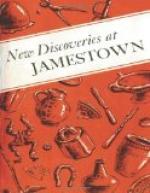[Illustration: Ornamental plaster was used in A few buildings for enhancing the beauty of both the interior and exterior.]
[Illustration: The interior of A small Jamestown house, about 1650. Although the painting is conjectural, many items Shown—pottery, glassware, fireplace tools, and kitchen accessories—were unearthed on this historic island. (Painting by Sidney E. King.)]
PLASTER AND MORTAR
Plaster and mortar have been found at Jamestown in abundance. It appears that the majority of brick houses and many frame structures had plastered walls and ceilings after 1635. Some plaster found had been whitewashed, while other plaster bore its natural whitish-gray color. Mortar was found wherever brick foundations were located. The plaster and mortar used at Jamestown was made from oystershell lime, sand, and clay.
ORNAMENTAL PLASTERWORK
Ornamental plaster was found in a few of the excavations. The plasterwork was done in raised ornamental designs used for enhancing the beauty of both the interior and exterior of a building. Designs that have been found include Roman numerals, letters, mottos, crests, veined leaves, rosettes, flowers, geometric designs, a lion, and a face or mask. Many fragments of molded plaster cornices have also been excavated. Broken oyster shells are distinguishable in the decorated plasterwork, indicating that the pargeting was done at Jamestown.
House Furnishings
Busy conquering a stubborn wilderness, the first Jamestown settlers had only a few things to make their houses cosy and cheerful. In most cases, their worldly goods consisted of a few cooking utensils, a change of clothing, a weapon or two, and a few pieces of homemade furniture. However, between 1607 and 1612, George Percy was generously outfitted with some necessities as well as much fine apparel and numerous luxury items (including a feather bed) by his brother the Ninth Earl of Northumberland, as published records of the Earl’s expenditures for George show. Other persons of gentle birth and position quite probably enjoyed similar goods.
After the early years of hardship had passed, the colonists began to acquire possessions for a more pleasant living; and by 1650 the better houses were equipped with most of the necessities of life of those times, as well as a few luxuries of comfortable living.
FURNITURE
Very little furniture was brought over from England during the early years of the colony. Perhaps a few chests and Bible boxes were imported, but most of the large pieces of furniture, such as tables, chairs, bedsteads, chests-of-drawers, cupboards, benches, and cradles would have been made in Virginia. Woods commonly used included pine, cedar, walnut, maple, and oak.




